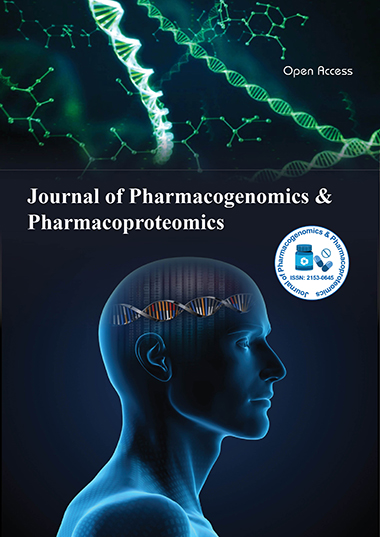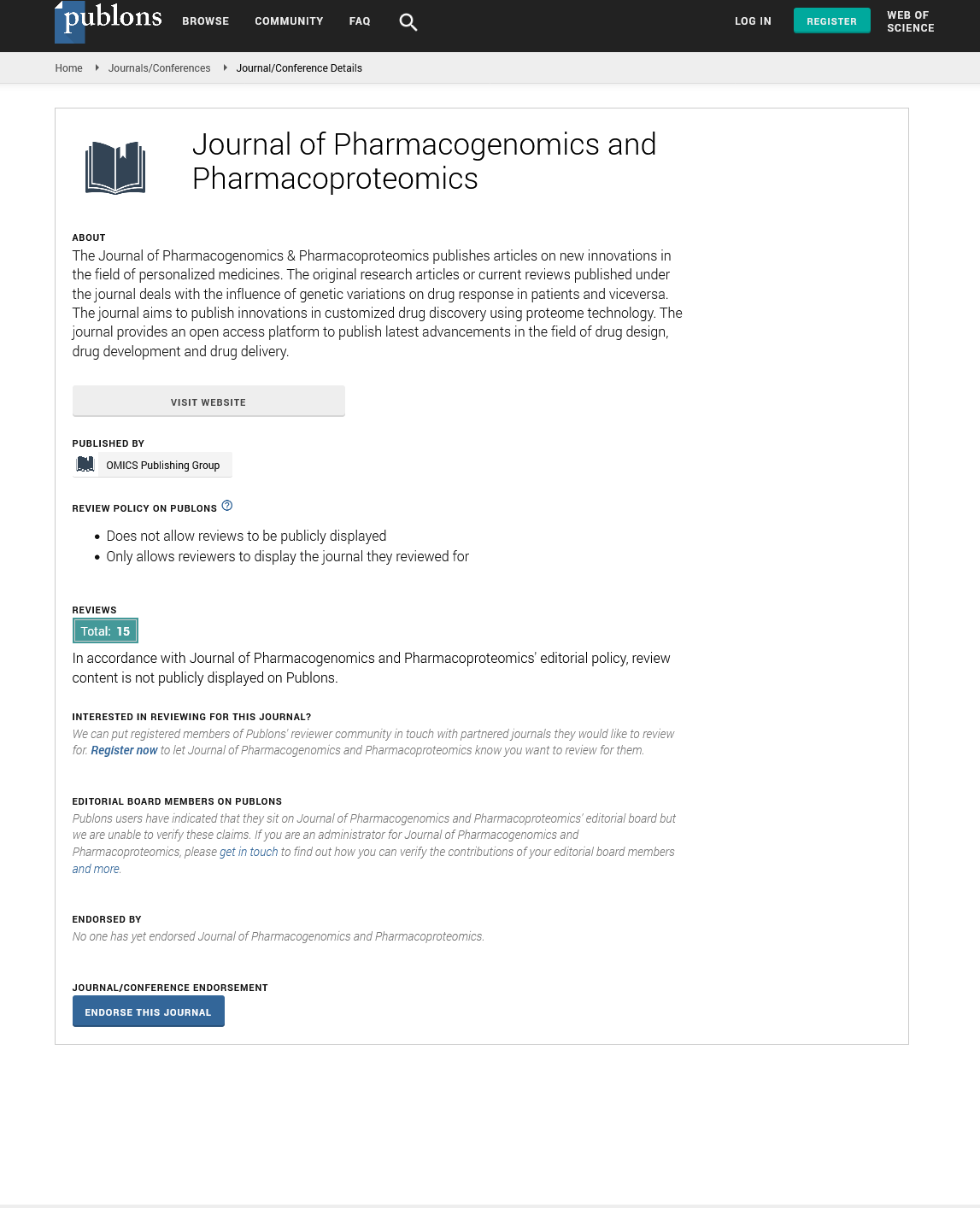Indexed In
- Open J Gate
- Genamics JournalSeek
- Academic Keys
- JournalTOCs
- ResearchBible
- Electronic Journals Library
- RefSeek
- Hamdard University
- EBSCO A-Z
- OCLC- WorldCat
- Proquest Summons
- SWB online catalog
- Virtual Library of Biology (vifabio)
- Publons
- MIAR
- Euro Pub
- Google Scholar
Useful Links
Share This Page
Journal Flyer

Open Access Journals
- Agri and Aquaculture
- Biochemistry
- Bioinformatics & Systems Biology
- Business & Management
- Chemistry
- Clinical Sciences
- Engineering
- Food & Nutrition
- General Science
- Genetics & Molecular Biology
- Immunology & Microbiology
- Medical Sciences
- Neuroscience & Psychology
- Nursing & Health Care
- Pharmaceutical Sciences
Perspective - (2025) Volume 16, Issue 2
The Role of Pharmacogenomics and Pharmacoproteomics in Neurodegenerative Disease Therapy
Ananya Khanna*Received: 02-Jun-2025, Manuscript No. JPP-25-29916; Editor assigned: 04-Jun-2025, Pre QC No. JPP-25-29916(PQ); Reviewed: 16-Jun-2025, QC No. JPP-25-29916; Revised: 23-Jun-2025, Manuscript No. JPP-25-29916(R); Published: 30-Jun-2025, DOI: 10.4172/2153-0645.25.16.138
Description
Neurodegenerative diseases such as Alzheimer’s disease, Parkinson’s disease, amyotrophic lateral sclerosis and Huntington’s disease are among the most devastating conditions affecting humanity today. They are characterized by progressive neuronal loss, leading to severe cognitive, motor and functional impairments. Despite decades of research, treatments remain largely symptomatic, presenting limited benefit in halting or reversing disease progression. The challenge is amplified by the enormous heterogeneity observed among patients. The same therapeutic intervention can yield substantial improvement in one patient while producing negligible results or even adverse effects in another. This variability underscores the need for personalized approaches that take into account the genetic, molecular and proteomic context of each patient.
Pharmacogenomics and Pharmacoproteomics together offer a comprehensive solution to this challenge, opening pathways to precision therapy in neurodegenerative disease.
Pharmacogenomics has already uncovered important genetic determinants that shape drug response in neurological conditions. For instance, polymorphisms in the APOE gene are well known to influence both the risk of developing Alzheimer’s disease and the response to therapies aimed at amyloid clearance. Patients carrying the APOE ε4 allele show different outcomes compared to non-carriers when treated with certain monoclonal antibodies against amyloid beta. Similarly, genetic variants in enzymes involved in neurotransmitter metabolism can alter drug response in Parkinson’s disease. The COMT gene, which encodes Catechol-O-methyltransferase, plays an essential role in dopamine metabolism. Variants in this gene influence how patients respond to levodopa, the cornerstone of Parkinson’s treatment. Those with certain COMT genotypes may experience shorter or longer durations of therapeutic benefit, shaping dosing strategies.
While pharmacogenomics provides information about inherited predispositions, Pharmacoproteomics complements this by analyzing the proteins that are actively expressed and modified in diseased neurons and surrounding tissues. Neurodegenerative diseases are often driven by protein misfolding, aggregation, and dysfunction. Proteomic profiling enables researchers to map these aberrant protein networks, revealing biomarkers that can predict therapeutic efficacy or resistance. For example, in Alzheimer’s disease, proteomic analysis of cerebrospinal fluid has identified distinct protein signatures, such as increased tau phosphorylation or altered synaptic proteins, which can serve as early indicators of disease progression and treatment response. These markers provide dynamic insights into disease biology, far beyond what genomic data alone can capture.
Integrating pharmacogenomics and proteomic data is essential for designing individualized therapeutic strategies. For instance, in Parkinson’s disease, a patient’s COMT and LRRK2 genotypes, combined with proteomic profiles of alpha-synuclein aggregation and dopamine transporter expression, can inform optimal levodopa dosing, predict the risk of motor complications, and guide adjunctive therapy choices. Similarly, in Alzheimer’s disease, combining APOE genotype with proteomic biomarkers such as neurogranin, YKL-40, and synaptic proteins enables early stratification of patients for clinical trials or tailored treatment plans. This integration ensures that therapy is not only based on static genetic information but also reflects the real-time physiological state of the patient.
The practical applications of this integrated approach are already emerging. Advanced mass spectrometry platforms and high-throughput protein assays allow clinicians to monitor proteomic changes in response to therapy. For example, tracking longitudinal changes in cerebrospinal fluid proteins can indicate whether a patient is responding to disease-modifying treatments, even before clinical symptoms improve. Such monitoring enables early intervention, adjustment of therapeutic regimens, or discontinuation of ineffective drugs, minimizing side effects and healthcare costs.
Furthermore, Pharmacoproteomic profiling can help identify novel therapeutic targets. Aberrant protein networks revealed through proteomics often indicate pathways that drive neurodegeneration, which can then be targeted by small molecules, antibodies, or gene therapy approaches. By overlaying these proteomic insights with pharmacogenomics data, researchers can predict which patient subgroups are most likely to benefit from these novel interventions, improving the success rate of clinical trials and accelerating drug development.
Despite these advances, challenges remain. Neurodegenerative diseases involve complex interactions between genetics, protein networks, environmental exposures, and aging-related processes. Integrating pharmacogenomics and proteomic data into clinically actionable insights requires sophisticated computational models, large patient cohorts for validation, and multidisciplinary collaboration between neurologists, geneticists, proteomic scientists, and bioinformaticians. Moreover, ethical considerations surrounding genetic and proteomic data must be addressed, including patient consent, privacy, and the potential psychological impact of revealing risk information for untreatable conditions.
Citation: Khanna A (2025) The Role of Pharmacogenomics and Pharmacoproteomics in Neurodegenerative Disease Therapy. J Pharmacogenom Pharmacoproteomics. 16:138.
Copyright: ©2025 Khanna A. This is an open-access article distributed under the terms of the Creative Commons Attribution License, which permits unrestricted use, distribution and reproduction in any medium, provided the original author and source are credited.

